Skip to comments.
A Significant "Hole" in "Unprecedented" 20th-Century Global Warming
Co2 Science ^
| Jan 2007
| Co2 Science
Posted on 02/19/2007 4:15:42 PM PST by DaveTesla
Reference
Kunkel, K.E., Liang, X.-Z., Zhu, J. and Lin, Y. 2006.
Can CGCMs simulate the twentieth-century "warming hole"
in the central United States? Journal of Climate 19:
4137-4153.
Background
Citing the work of Folland et al. (2001), Robinson et
al. (2002) and Pan et al. (2004), the authors note there
was a lack of warming throughout the central and
southeastern United States over the course of the 20th
century, which phenomenon was dubbed a "warming hole" by
the latter set of investigators.
What was done
For an area they denote the Central United States (CUS),
which they describe as "one of the most agriculturally
productive regions of the world and roughly defined
around what is known as the 'Corn Belt'," Kunkel et al.
used a data set of 252 surface climate stations with
less than 10% missing temperature data over the period
1901-1999 to construct the CUS temperature time series
plotted in the figure below, where mean global
temperature as determined by Hansen et al. (2001) is
also plotted. Then, for comparative purposes, they
examined 55 coupled general circulation model (CGCM)
simulations driven by "modern estimates of time-varying
forcing," plus 19 pre-industrial unforced simulations,
all derived from 18 CGCMs.

Figure 1. Twentieth-century Central United States and
mean global temperature anomalies, as described in the
text above. Adapted from Kunkel et al. (2006).
What was learned
It is obvious, as shown in the figure above, that the
Central US 20th-century temperature series is vastly
different from that of the globe as a whole, at least as
it is represented by Hansen et al. In fact, rather than
the final temperature of the 20th century being
unprecedented over the past two millennia, as climate
alarmists typically claim, the final 20th-century
temperature of the Central US was more than 0.7°C cooler
than it was a mere 65 years earlier. In addition, Kunkel
et al. report that "the warming hole is not [our
italics] a robust response of contemporary CGCMs to the
estimated external forcings."
What it means
In the words of the researchers who conducted the
study, "the warming hole indicates that anthropogenic
forcing of the climate system can be accompanied by a
regional temperature response different than expected,"
which fact "has important implications for impacts
assessments." Indeed, it suggests that such model-based
assessments can be radically wrong. It is also of
interest to note that "during the period of most
significant greenhouse gas buildup over the past
century, i.e., 1930 and onward" - as we repeat issue
after issue in our Temperature Record of the Week
feature - the bulk of the United States, whose 20th-
century CO2 emissions exceeded those of all other
nations, experienced no net warming.
References
Folland, C.K. and Coauthors. 2001. Observed climate
variability and change. In: Houghton, J.T. et al.
(Eds.), Climate Change 2001: The Scientific Basis,
Cambridge University Press, Cambridge, UK, pp. 99-181.
Hansen, J., Ruedy, R., Sato, M., Imhoff, M., Lawrence,
W., Easterling, D., Peterson, T. and Karl, T. 2001. A
closer look at United States and global surface
temperature change. Journal of Geophysical Research 106:
23,947-23,963.
Pan, Z., Arritt, R.W., Takle, E.S., Gutowski Jr., W.J.,
Anderson, C.J. and Segal, M. 2004. Altered hydrologic
feedback in a warming climate introduces a "warming
hole." Geophysical Research Letters 31: 10.1029/2004GL 020528.
Robinson, W.A., Reudy, R. and Hansen, J.E. 2002. On the
recent cooling in the east-central United States.
Journal of Geophysical Research 107:
10.1029/2001JD001577.
TOPICS: Constitution/Conservatism; Culture/Society; News/Current Events
KEYWORDS: climatechange; globalwarming
 Never mind that silly science stuff.
Never mind that silly science stuff.
Drink your Kool-Aid!
1
posted on
02/19/2007 4:15:43 PM PST
by
DaveTesla
To: DaveTesla; Killing Time; Beowulf; Mr. Peabody; Mrs. Don-o; RW_Whacko; honolulugal; gruffwolf; ...

Click graphic for full GW rundown
Ping me if you find one I've missed.
2
posted on
02/19/2007 4:19:53 PM PST
by
xcamel
(Press to Test, Release to Detonate)
To: DaveTesla
Does that mean I won't get my government grant to grow huge sponges to sop up the rise in sea levels due to man made global warming?:)
3
posted on
02/19/2007 4:29:51 PM PST
by
HuntsvilleTxVeteran
(Vote for RINOS, lose and complain by sending a self-abused stomped elephant.)
To: DaveTesla
The late John L. Daly noted this descrepency between US and global measurments on his "Still Waiting for Greenhouse" webstite:
The `Surface Record' 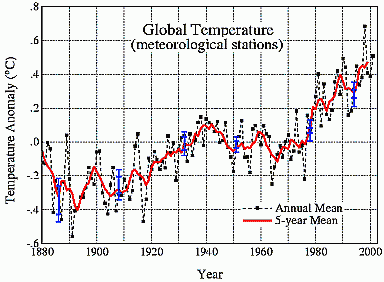
It's not really a record at all, but a statistical composite from station records from all over the world, most of them from towns and cities, and most from countries which do not maintain their stations or records properly. This record is compiled by the Goddard Institute (GISS) in the US. It indicates a global warming of +0.8°C. Is it real? Or is it just a statistical product of urban warming skewing the data, and bad site management in non-OECD countries? The pre-1940 warming is widely regarded to have been caused by the warming sun during the earlier part of the 20th century.
The U.S. Record 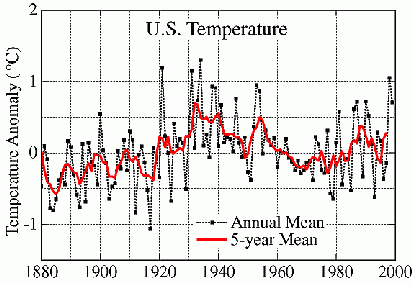
This is the combined record from hundreds of weather stations in the 48 states of the contiguous USA., the early 1930s being the hottest years of the 20th century. This is completely at variance with the global record shown above. (Both graphs were produced by NASA-GISS) Urbanisation has been more successfully corrected for in the US than in the rest of the world and the US also has the best maintained network of weather stations in the world. This must therefore be a better representation of the global picture too. The US record also agrees with the satellites (shown below)
4
posted on
02/19/2007 4:31:07 PM PST
by
Dan Evans
To: DaveTesla
Simple, Red states are cooler than blue states!
To: DaveTesla
A few observational interpretations from your humble servant, a sometimes computer modeler:
1. Your mission is to model a very large area. For one small portion, you have very good data extending back for at least a century. For other, vast areas, these data are missing or incomplete. What do you, the consumate computer modeler do? Make shi## up. No problem. The model now works, the guys paying the bills are happy, its Miller time.
2. After all your hard work to become a world reknowned climate modeler, some moron scientists start using actual empirical data to challenge your assumptions and your algorithms. No problem, climate science is governed by consensus, especially from "scientists" whose fields have nothing whatsoever to do with either weather or climate.
3. Bottom line: your climate model is crap, but it doesn't matter - politics don't need no stinkin' data.
6
posted on
02/19/2007 4:55:51 PM PST
by
centurion316
(Democrats - Supporting Al Qaida Worldwide)
To: Andrewksu
forgot to add you to the address list.
7
posted on
02/19/2007 5:04:49 PM PST
by
centurion316
(Democrats - Supporting Al Qaida Worldwide)
To: DaveTesla
Some claim that global warming will melt ice and raise sea levels...
Hmm - when the ice in my drink melts - does the glass then overflow?
Don't think so - so much stupidity.
THE ICE IS ALREADY IN THE WATER YOU IDIOTS.
To: Dan Evans
Black body irradiance / emissivity, radiation / absorption (Stefan-Boltzmann)
play a big role in this error.
Pavement, Buildings and other man made structures absorb more heat. Possibly a lot more the the 0.6 degrees caused by the proposed man made global warming.
So global warming is man made!
Lets tear down all the buildings and sleep in the woods
like there doing in Venezuela!
Viva the commie back to the stone age and die young revolution!
9
posted on
02/19/2007 5:08:35 PM PST
by
DaveTesla
(You can fool some of the people some of the time......)
To: DaveTesla
Helps to look at it on a longer time frame. (Read astronomical time frame.)
Last 10,000 years.
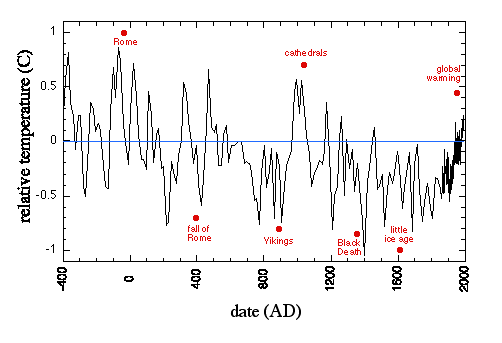
Last 100,000 years.
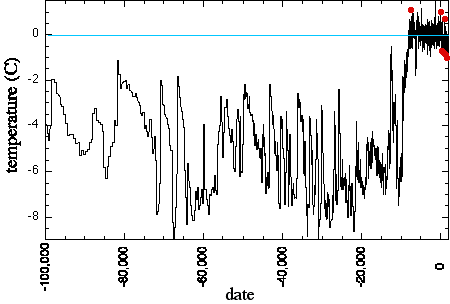
Last 420,000 years.
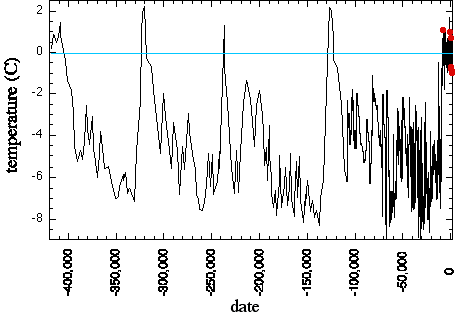
http://muller.lbl.gov/pages/IceAgeBook/history_of_climate.html
Other References
http://www.pnas.org/cgi/reprint/94/16/8329.pdf http://www.clim-past-discuss.net/2/371/2006/
10
posted on
02/19/2007 6:15:40 PM PST
by
Trityn
(Either way buy plenty of insulation for your attic.)
To: Jake The Goose
"Hmm - when the ice in my drink melts - does the glass then overflow? Don't think so - so much stupidity."The big big big difference between your drink and the globe - aside from the scale, of course - is that the ice in your drink is ALREADY in the water. Most of the ice at our poles is NOT. Which still doesn't mean that global warming is not a silly hoax - it certainly is - but do let's make rational comparisons.
11
posted on
02/19/2007 7:40:00 PM PST
by
Redbob
To: Trityn
What does the lag of CO2 behind Global temperature tell us about global warming?
I have my own hypotheses.
1. The earth's oceans act as a carbon sink.
When the earth heats up due to multiple influences,
(solar activity, orbital tilt, cloud cover, cosmic rays etc) the oceans warm due to heat absorption and currents.
2. When the oceans warm they out-gas Co2.
This has a limited effect on global temperatures.
EVEN if we increased the earth's Co2 level four fold it
would have very little effect because the infrared absorption of Co2
is logarithmic. In fact it is now near saturation.
3. As the Oceans cool (as they are starting to do now)
they begin to absorb Co2.
4. There is nothing wrong with the earths climate.
It is working as it should.
5. The communists are saying we must save the planet
by reducing our energy use by TAXING the more wealthier
nations. Of course the communist country's are exempt.
This is nothing more than the old Marxist redistribution
or wealth.
The Marxists will tax us, give 5 cents on the dollar
to the oppressed (of course they are the oppressors in the
first place) and pocket the other 95 cents.
This has no effect on global temperatures but will put
plenty of ice on the economy's of productive nations.
Thats where the real crisis will begin.
Fed Hayek was right.
Slavery starts with government control.
And the global warming scam is Marx, Stalin and Mao's dream come true.
The communists failed at the Running out of oil scam,
the over population scam, the famine scam, the nuclear power scam, the ozone scam, the Y2K scam etc...
Yet public keeps falling for their "the world is coming to
an end", get on your knees and big government will save
you. (Who needs God or Jesus when you have them?).
All at a little price...
Give them all your money (labor) so they can live like the
gods (little "g") that they perceive they are.
Oh and one more thing since the government now gives you life
when you cost them too much you will simply have to go.
Power Kills
12
posted on
02/19/2007 7:53:35 PM PST
by
DaveTesla
(You can fool some of the people some of the time......)
To: DaveTesla
To: DaveTesla
I believe your hypothesis is in good sync (pun intended) with the link posted below. It is to a presentation that discusses the ice/CO2 cycle which again comes back to the 100,000 year cycles, of which we are in the hotter part and about to head down the cooling slope in a big way.
http://www.copernicus.org/EGU/cp/cpd/2/371/cpd-2-371.pdf
If these Global Warming Jihadists adhered in any way to a scientific process they would review and counter these theories with facts and analysis instead of trying to revoke earned accreditations for those who dare present opposing theories.
I agree it is more a power grab by the looney left than any concern for the environment or their fellow man.
14
posted on
02/20/2007 5:47:40 PM PST
by
Trityn
(Either way buy plenty of insulation for your attic.)
Disclaimer:
Opinions posted on Free Republic are those of the individual
posters and do not necessarily represent the opinion of Free Republic or its
management. All materials posted herein are protected by copyright law and the
exemption for fair use of copyrighted works.
FreeRepublic.com is powered by software copyright 2000-2008 John Robinson







